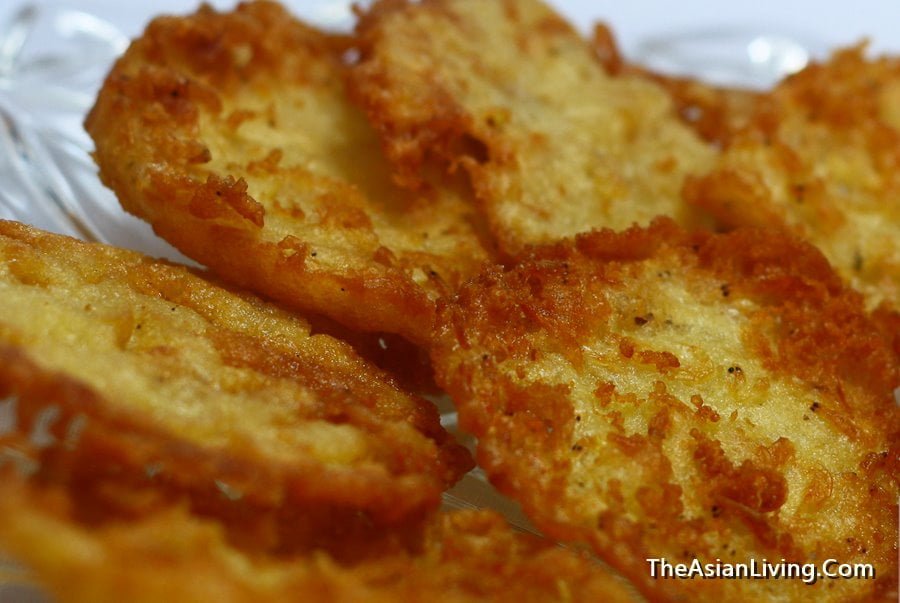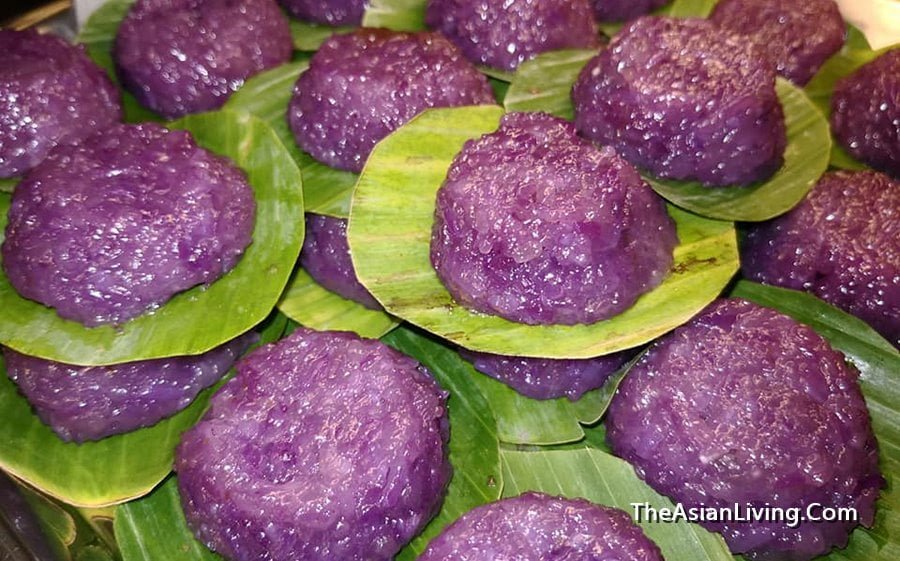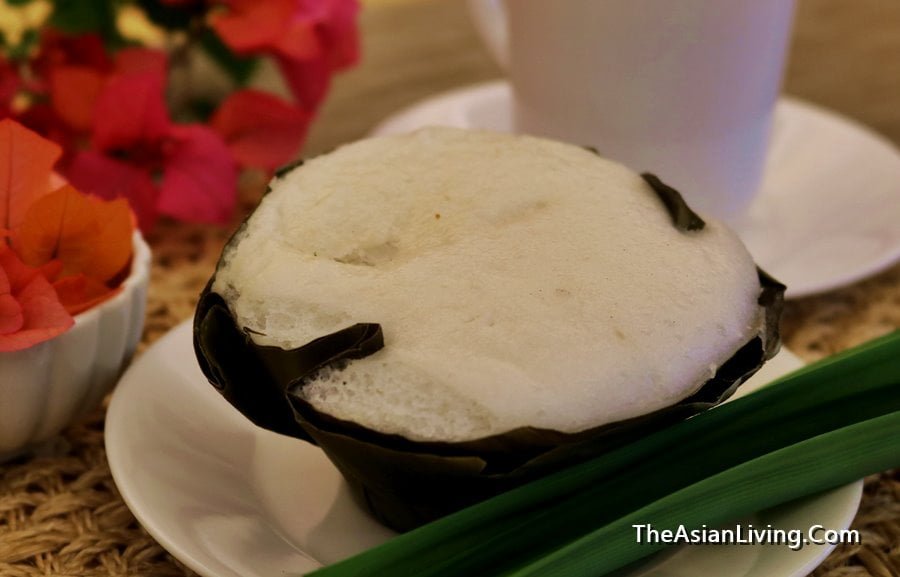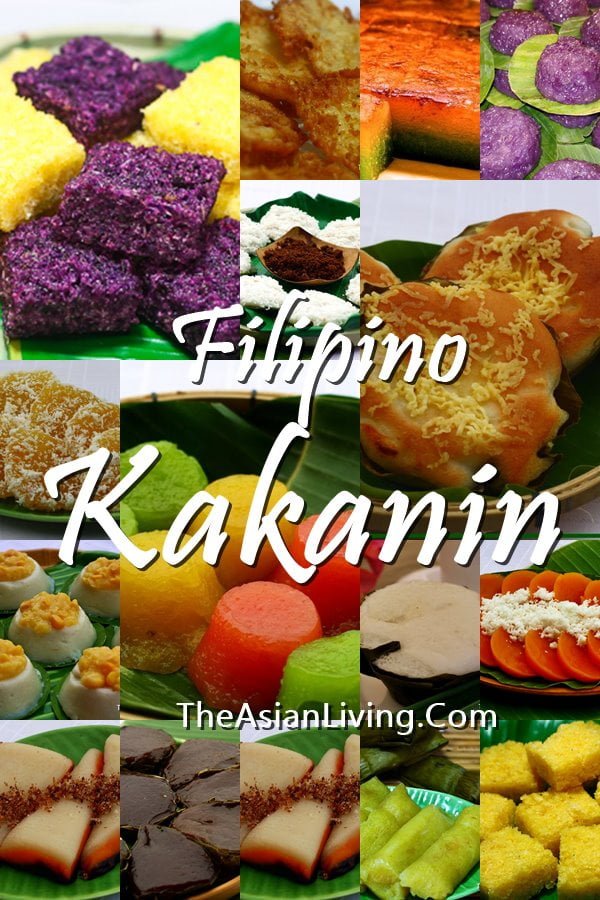
Kakanin | Native Delicacies in the Philippines
Table of Contents
Kakanin: My Top Picks of Philippine Native Delicacies
Kakanin is an umbrella term for several indigenous snacks made from glutinous rice or other local ingredients like cassava. Most often than not, these kakanin/native delicacies are slowly cooked with coconut milk.
The word kakanin comes from two Tagalog words, “kain” (to eat) and “Kanin” (rice). Kakanin refers to Filipino native delicacies that are usually eaten as a dessert or snack and are essential in the Philippine culinary tradition.
Kakanin defines the historical culture of the Philippines. Our family had a favorite seller who made various delights and delivered this kakanin to our house in time for breakfast and afternoon snacks. During my college days, eating kakanin was memorable and nostalgic. My mother would ensure my kakanin was brought into our house during the weekend when I went home because she knew I enjoyed eating them.
Kakanin embodies the love of the Philippines in preparation for the complex and meticulous cooking process. Although the changing market brings numerous flavors to the palate of the country’s people, these foods remained extremely important for vendors and locals alike.
Top Native Delicacies | Kakanin in the Philippines

Kakanin | Native Delicacies in the Philippines
1. Suman Latik
Suman Latik is a delectable rice cake showcasing coconut milk’s rich flavors and the art of traditional wrapping. This Filipino delicacy is made by combining rice with coconut milk and wrapping it in banana leaves. What sets Suman Latik apart is the addition of “Latik” or coco jam, which is generously spread on top of the rice cake when served, adding a burst of sweetness and enhancing its overall taste.
The art of wrapping Suman Latik is a craft in itself. While palm leaf is commonly used, other materials such as bamboo, anahaw, or banana leaves can also be utilized. The wrapping styles can vary, ranging from vertical folds to pyramid shapes or even complex octahedral forms with intricate rectangular folds. Each style adds to Suman Latik’s visual appeal, showcasing the maker’s skill and creativity.
When served, the Suman Latik is generously topped with Latik, a thick coconut caramel made from simmering coconut cream and sugar. This heavenly addition further enriches the flavor profile and adds a delightful sweetness to the already delicious rice cake.

Kakanin | Native Delicacies in the Philippines
2. Kutsinta
Kutsinta, a favorite of mine, is a delicious kakanin that never fails to delight. This treat is topped with grated coconut or cheese for added flavor and texture, made from a mixture of rice flour, sugar, lye, and food coloring. Carefully blending these ingredients and steaming results in a firm and satisfying texture.
To create Kutsinta, rice flour, sugar, lye, and a touch of food coloring are combined to form a smooth batter. The batter is then poured into individual molds and steamed until it reaches the desired consistency. The result is a soft and chewy delicacy with a distinctively sweet flavor.
Kutsinta is often served with grated coconut, which adds a creamy and tropical element to the dish. Alternatively, some people enjoy it with grated cheese, offering a delightful salty contrast to the sweetness of the kakanin.

Kakanin | Native Delicacies in the Philippines
3. Palitaw
Palitaw is a delightful Filipino delicacy consisting of flattened sweet rice cakes. Made from a simple rice flour and water mixture, Palitaw is prepared by shaping the dough into small balls and then flattening them into discs. These discs are dropped into boiling water, and they are perfectly cooked once they rise to the surface.
Palitaw is traditionally served with grated coconut and muscovado sugar, offering a delightful contrast of flavors. The sweet and nutty taste of muscovado sugar complements the subtle sweetness of the rice cakes, while the grated coconut adds a creamy and tropical touch. To further enhance the experience, Palitaw can be sprinkled with sesame seeds for added texture and aroma.

Kakanin | Native Delicacies in the Philippines
4. Sapin-Sapin
Sapin-Sapin is a delightful and visually striking Filipino dessert known for its vibrant colors and layers. This kakanin features a multicolored rice cake with distinct white, orange, and purple layers. It is traditionally enjoyed with coco flakes and sugar, making for a delightful combination of flavors and textures. Sapin-Sapin pairs well with various beverages, enhancing the overall dining experience.
A rice flour batter is divided into different portions and flavored with various ingredients to create Sapin-Sapin. The white layer is often flavored with coconut milk, giving it a subtle and creamy taste. The orange layer is infused with ube or purple yam, providing a unique and vibrant hue. The purple layer, usually made with purple yam or ube, adds a rich and earthy flavor to the dessert.
After steaming each layer individually, they are carefully stacked on top of one another to create the visually appealing striped effect of Sapin-Sapin. The dessert is then topped with coco flakes and sugar, which add texture and sweetness to each bite.

Kakanin | Native Delicacies in the Philippines
5. Ibos
Suman sa Ibos is a delightful Filipino delicacy made from coconut milk and glutinous rice. This kakanin is complemented by the mango fruit’s sweet and juicy taste. Suman sa Ibos is a unique wrapper made from buri or palm leaves, which adds a distinctive touch to the presentation and flavor.
To create Suman sa Ibos, glutinous rice is soaked in coconut milk, allowing it to absorb the rich flavors. The mixture is then carefully wrapped in buri or palm leaves, giving it a charming and rustic appearance. The leaves substitute for the traditional banana leaf wrap, adding a unique element to the overall experience.
When enjoying Suman sa Ibos, it is often paired with ripe mango slices. Combining the sticky and creamy suman with the sweet and tangy mango creates a delightful contrast of flavors and textures. The coconut milk’s richness and the palm leaves’ fragrance further enhance the taste of this beloved Filipino delicacy.
6. Cassava Pudding
Cassava Pudding holds a special place as one of the most beloved kakanins in the Philippines. This delightful dessert is made from grated cassava, brown sugar, and a few strips of coconut to add a distinct and tropical flavor.
To create Cassava Pudding, the cassava is grated and mixed with brown sugar, which adds a rich and caramel-like sweetness to the dish. The grated cassava and sugar are combined thoroughly, allowing the flavors to meld together. The mixture is then placed in a baking dish and baked until it sets, resulting in a pudding-like consistency.
Adding coconut strips enhances the overall taste of the Cassava Pudding, providing a subtle yet delightful tropical twist. The coconut strips infuse the dessert with natural sweetness and a hint of nuttiness, elevating the flavor profile and adding a pleasing texture.

Kakanin | Native Delicacies in the Philippines
7. Maja Blanca
Maja Blanca is a delightful Filipino dessert made from coconut extract, ground rice or cornstarch, and sugar to taste. This creamy and sweet treat is best enjoyed with additional toppings such as creamed sweet corn or crushed peanuts.
To create Maja Blanca, coconut extract is simmered with ground rice or cornstarch to achieve a thick and smooth consistency. Sugar is added to sweeten the mixture according to personal preference. The resulting mixture is then poured into a mold and set until firm.
Once the Maja Blanca is set and ready to be served, it is traditionally topped with creamed sweet corn, which adds a burst of sweetness and a pleasant contrast in texture. Alternatively, crushed peanuts can be sprinkled on top, providing a delightful crunch and a nutty flavor that complements the creamy base.
8. Ube Pudding
Ube Pudding is a delicious Filipino dessert that showcases the vibrant and distinctive purple yam, known as “ube,” as its star ingredient. This delectable treat offers a delightful twist to the traditional cassava cake by utilizing freshly harvested purple yam.
In Ube Pudding, the purple yam is grated or mashed and combined with other ingredients such as coconut milk, condensed milk, eggs, and sugar to create a luscious and creamy pudding-like texture. The natural vibrant purple hue of the ube gives the dessert its striking appearance.
Similar to cassava cake, Ube Pudding is baked until it sets and develops a tender yet slightly dense consistency. The combination of flavors, including the subtle sweetness of the purple yam and the richness of the coconut milk, creates a delightful balance that many enjoy.

Kakanin | Native Delicacies in the Philippines
9. Pitsi-Pitsi
Pitsi-Pitsi, a beloved Philippine dessert, is made with a combination of sugar, cassava, and lye. Like other Philippine desserts, Pitsi-Pitsi is steamed until fully cooked, resulting in a delightful and flavorful treat. It is traditionally served with grated coconut, enhancing the overall taste and texture.
To create Pitsi-Pitsi, grated cassava is mixed with sugar and a small amount of lye (a traditional ingredient used in Filipino cooking). The mixture is then steamed, allowing the flavors to meld together and the ingredients to tender.
Once cooked, Pitsi-Pitsi is typically served with freshly grated coconut. The dessert’s sweet and slightly chewy texture pairs perfectly with the fragrant and creamy grated coconut, creating a harmonious balance of flavors.

Kakanin | Native Delicacies in the Philippines
10. Cassava Pandan
Cassava Pandan is a delightful variant of Cassava Pudding that features the vibrant green color and aromatic flavor of pandan leaves. This kakanin offers a unique twist to the classic Cassava Pudding, adding a layer of visual appeal and a hint of pandan’s distinct essence.
Grated cassava is combined with coconut milk, sugar, and pandan juice extracted from pandan leaves to create Cassava Pandan. The pandan leaves impart a lovely green hue to the mixture, giving the kakanin its characteristic appearance. The ingredients are then steamed or baked until the cassava becomes tender and the flavors meld together.

Kakanin | Native Delicacies in the Philippines
11. Ukoy
My apologies for the confusion in the previous response. Allow me to provide the correct information:
Ukoy is a specially-made Filipino fritter with shrimp as its main ingredient, rather than sticky rice. This delightful kakanin is a popular snack known for its crispy texture and savory flavor.
To prepare ukoy, fresh shrimp are mixed with a batter made from rice flour, cornstarch, egg, and various seasonings. The mixture is then deep-fried until it becomes golden and crispy. The result is a delectable cake with a flavorful shrimp filling encased in a light and crunchy coating.
Ukoy is often enjoyed as a tasty appetizer or street food treat. It’s crisp exterior and juicy shrimp filling make it a delightful snack that can be enjoyed on its own or dipped in a vinegar-based sauce for an added tangy kick.

Kakanin | Native Delicacies in the Philippines
12. Puto Lanson or Puto Taktak
Puto Lanson, a well-loved Filipino delicacy, is made from grated cassava thoroughly dried, steamed, and often brushed with butter before serving. This delectable treat showcases the versatility and unique flavors of cassava, a staple root crop in the Philippines.
To create Puto Lanson, cassava is grated and dried to remove excess moisture. The resulting cassava is then steamed, transforming into a soft and chewy texture. This cooking process brings out the natural sweetness of the cassava, making each bite a delightful experience.
Before serving, Puto Lanson is often brushed with butter, adding richness and enhancing the overall taste. This step provides a wonderful buttery aroma and a slight hint of indulgence.

Kakanin | Native Delicacies in the Philippines
13. Alupi –
Alupi, a delightful kakanin, is made by steaming grated cassava mixed with white sugar and wrapped in banana leaves. This traditional Filipino delicacy is known for its unique texture and flavor profile. Young coconut is added to enhance the overall experience, providing a delightful combination of textures and a refreshing burst of flavor.
Creating alupi involves blending grated cassava and white sugar, creating a sweet and sticky mixture. This mixture is carefully wrapped in banana leaves, which adds a pleasant aroma and helps retain moisture during the steaming process.
The addition of young coconut to alupi elevates its taste and texture. The tender coconut meat provides a contrasting texture to the chewiness of the cassava while imparting a subtly sweet and refreshing note. The combination of grated cassava, sugar, and young coconut creates a harmonious blend of flavors that make alupi an irresistible Filipino delicacy.

Kakanin | Native Delicacies in the Philippines
14. Biko
Suman, a Filipino kakanin, is a beloved native delicacy made from sticky rice, brown sugar, and coconut milk. It is a delightful treat enjoyed by many across the country. Its versatility makes suman truly special, with various regional and flavor variations to suit different preferences.
One popular variant is pandan suman, which infuses sticky rice with the aromatic flavor and vibrant green color of pandan leaves. Another delightful variation is purple yam suman, where the sticky rice is mixed with purple yam (ube), creating a unique and visually appealing treat. Additionally, suman Tagalog is a classic version made with plain sticky rice, showcasing the simplicity and authentic flavors of this traditional kakanin.
No matter the variant, suman is typically wrapped in banana leaves and then steamed or boiled to perfection. The result is a deliciously sticky and sweet rice cake that can be enjoyed on its own or paired with various dips and sauces like coconut caramel (latik) or sugar.
15. Puto
Puto, the well-known kakanin, holds a special place in Filipino cuisine. It is a steamed rice cake that has become a beloved treat nationwide. While traditionally white, puto has evolved in appearance, with variations now available in vibrant colors such as pink, yellow, and purple.
Pairing perfectly with puto are popular Filipino dishes like dinuguan, a savory blood meat stew, and pansit bihon, a flavorful rice noodle dish with meat and vegetables. The combination of these dishes creates a delightful balance of flavors, making them an ideal match for the subtle sweetness of puto.
Moreover, puto has undergone flavor transformations in recent years. Some creative individuals have infused it with distinct tastes, such as pandan and purple yam. These additions not only enhance the flavors but also add a colorful touch to the already delightful puto.

Kakanin | Native Delicacies in the Philippines
16. Bibingka
Bibingka, a beloved Filipino kakanin, is a ground rice cake made with coconut milk, galapong (rice flour batter), and sugar. This delightful treat carries with it a rich cultural tradition. Traditionally, it is baked in an improvised oven fueled by charcoal, giving it a distinct smoky flavor and a unique texture.
Over time, some delicious enhancements have been introduced to elevate the bibingka experience. One popular addition is “itlog na maalat” (salted egg), used as a topping or a filling. The creamy saltiness of the egg perfectly complements the sweetness of the cake. Additionally, cheese or butter is commonly used as toppings, adding a savory twist to the overall flavor profile.
During the Christmas season, bibingka holds a special significance. It is traditionally enjoyed and sold in front of churches, creating a festive atmosphere. After the nine-day Simbang Gabi (night mass), it becomes even more prevalent, with people indulging in this delectable treat outside the church premises.
17. Kalamay Hati
Kalamay Hati, a delectable sticky delicacy, is a beloved treat in the Philippines. It is made with rice flour, brown sugar, and coconut milk, resulting in a delightful combination of flavors. Typically, this sweet delicacy is wrapped in banana leaves, which adds a hint of earthiness and a lovely aroma.
In certain provinces, a unique variation of Kalamay Hati can be found, where instead of using banana leaves, it is presented in coconut shells. This creative twist adds a touch of authenticity and showcases the coconut shell’s natural beauty as a serving container.

Kakanin | Native Delicacies in the Philippines
18. Yam-yam
The yam-yam is a beloved delicacy in the Philippines, known for its delightful taste and unique texture. This mouthwatering dessert is made primarily from cassava, a starchy root vegetable that adds a distinct flavor and consistency to the treat.
What sets the yam-yam apart is its texture, which can be described as soft, chewy, and slightly sticky. The cassava gives it a satisfying density that contrasts beautifully with its sweet and fragrant flavor. Whether enjoyed on its own or as a delightful accompaniment to a cup of hot chocolate or coffee, the yam-yam always brings joy to those who savor it.

Kakanin | Native Delicacies in the Philippines
19. Puto-Pao
Puto Pao is a delicious alternative to siopao, especially when flour is in short supply. Its name is derived from the combination of “puto” and “siopao.” This delightful treat takes the concept of siopao and transforms it into a meat-filled puto.
Originating from this creative blend, Puto Pao features the soft and fluffy texture of puto, a traditional Filipino steamed rice cake filled with savory meat. It offers a unique twist on the classic siopao, providing a delightful balance of flavors and textures in each bite.
Puto Pao has become a favorite among Filipinos, offering a convenient and scrumptious way to enjoy puto and siopao. Whether enjoyed as a snack or a satisfying meal, this fusion of flavors is a beloved treat for many.

Kakanin | Native Delicacies in the Philippines
20. Puto Tikoy
The puto tikoy is a delightful Filipino twist on the traditional Chinese tikoy, enjoyed by many during the festive celebration of Chinese New Year. It is a unique variation that combines the soft and sticky texture of tikoy with the light and fluffy goodness of puto, a famous Filipino steamed rice cake.
Made with glutinous rice flour, sugar, and water, puto tikoy retains its Chinese counterpart’s sweet and chewy characteristics while incorporating the beloved flavors of Filipino cuisine. The cake is steamed to perfection, resulting in a fluffy and slightly sticky treat enjoyed by both young and old alike.

Popular Posts
- FOOD PRESENTATION IDEAS | THAILAND
- HOW TO STAY LOOKING YOUNG IN YOUR 40’s
- Scarborough Seafood NGC: Where Culinary Delights Meet Seaside Charm
- Shibuya Crossing: Where the Bustle and Beauty of Tokyo Collide
- Joint Venture of Primeelectric and CENECO: Powering Progress
- Say YES to the JVA! | Joint Venture Agreement – Primelectric and CENECO
- Marketing and Entrepreneurship Department Teambuilding [USLS]
- Kimono: Unveiling the Timeless Elegance and Cultural Significance
- Quan Delicacies | Party Bilao: Elevating the Delight of Native Flavors
- Ramen: A Personal Journey in Japan’s Culinary Delights
- Sushi: Savoring the Delightful Artistry | Fabulous Asian Lifestyle
- Roco’s Studio Photography: A Fabulous Photoshoot Experience
- Spontaneity and Unfiltered Honesty: The Power of Authentic Expression
- Coffee Ground Exfoliation: Revive Your Skin with the Power of Nature
- Teacher-Student Affairs: Navigating Boundaries in Complex Relationships
- Bugana Beach and Dive Resort Sipalay | Fab Asian Lifestyle
- Sensitivity: Embracing the Strengths and Challenges
-



